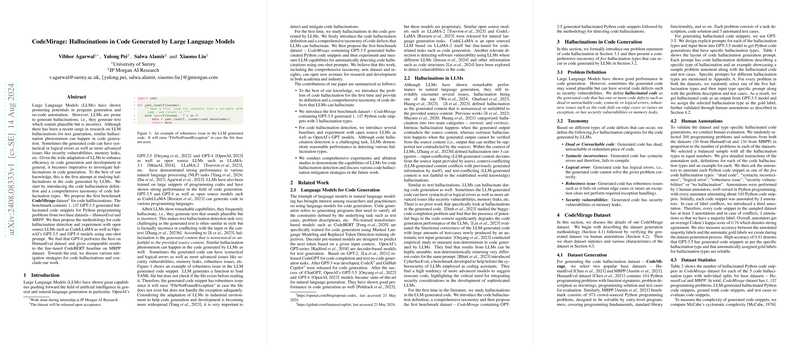CodeMirage: Hallucinations in Code Generated by LLMs
The paper "CodeMirage: Hallucinations in Code Generated by LLMs" authored by Vibhor Agarwal, Yulong Pei, Salwa Alamir, and Xiaomo Liu, addresses a crucial challenge in the domain of AI-driven code generation. With the increasing reliance on LLMs like GPT-3.5 and GPT-4 for automating programming tasks, understanding and mitigating the phenomenon of "code hallucinations" becomes critical. Code hallucination refers to instances where the LLM-generated code appears plausible but is riddled with underlying errors or vulnerabilities.
Introduction
The introduction sets the stage by acknowledging the advancements in LLM-driven code generation while highlighting an often-overlooked issue: hallucinations in generated code. Such hallucinations can manifest as syntactical or logical errors, security vulnerabilities, memory leaks, etc. The authors assert the necessity of a thorough investigation into this problem, marking their work as the pioneer in this area by proposing a novel dataset and defining a taxonomy for code hallucinations.
Methodology and Contributions
The paper's main contributions can be summarized as follows:
- Taxonomy of Code Hallucinations: The authors define code hallucinations and categorize them into five types: dead or unreachable code, syntactical incorrectness, logical errors, robustness issues, and security vulnerabilities. This comprehensive taxonomy provides a well-structured framework for future research.
- CodeMirage Dataset: A benchmark dataset containing 1,137 hallucinated code snippets generated by GPT-3.5 for Python programming problems. This dataset is derived from the HumanEval and MBPP datasets and categorized based on the identified taxonomy.
- Detection Methodology: The paper proposes a one-shot prompt methodology to detect hallucinations using LLMs. The model performance is evaluated using various metrics on their benchmark dataset.
- Experimental Results: Extensive experiments are conducted with multiple LLMs, including CodeLLaMA, GPT-3.5, and GPT-4, comparing their performance in detecting hallucinations against a fine-tuned CodeBERT model.
- Future Directions: Discussion on potential mitigation strategies, highlighting the scope for integrating traditional software engineering techniques with LLMs.
Dataset and Annotations
The CodeMirage dataset is meticulously crafted by inducing specific types of hallucinations into code snippets using explicit prompts fed into GPT-3.5. The generated code snippets were then validated through human annotations to ensure reliability. The dataset's statistical analysis further strengthens its robustness by illustrating the complexity and variety of hallucinations it encompasses.
Experimental Setup and Results
The authors evaluated the performance of several LLMs and provided compelling comparative results:
- CodeBERT: Fine-tuned on the CodeMirage dataset, the model achieved reasonable performance but highlighted the inherent complexity of the detection task.
- CodeLLaMA: Despite being an open-source model fine-tuned for code-related tasks, CodeLLaMA underperformed significantly in hallucination detection.
- GPT-3.5 and GPT-4: Both models were assessed using one-shot prompts. GPT-4 demonstrated superior performance, highlighting its efficacy in understanding and detecting code hallucinations.
The results indicate that while fine-tuned models like CodeBERT perform well, advanced LLMs such as GPT-4 can achieve comparable, if not better, results with minimal training, showcasing the potential of LLMs in real-time hallucination detection tasks.
Implications and Future Work
The implications of this research are multifaceted:
- Practical Implications: Organizations adopting LLMs for code generation can benefit from these findings to enhance the reliability and security of the generated code.
- Theoretical Implications: The proposed taxonomy and dataset lay a foundational framework for subsequent research, potentially leading to more sophisticated detection and mitigation strategies.
Future research directions suggested by the authors include:
- Enhanced LLM Fine-Tuning: Fine-tuning LLMs specifically for hallucination detection tasks might significantly improve their performance.
- Integration with Software Engineering Techniques: Leveraging compilers, ASTs, CFGs, and execution workflows can provide additional layers of verification and error-checking.
- Mitigation Strategies: Developing robust techniques to prevent hallucinations, such as knowledge-enhanced prompt tuning and retrieval-augmented code generation.
Conclusion
"CodeMirage: Hallucinations in Code Generated by LLMs" presents a significant step towards recognizing and addressing the nuanced challenges posed by LLM-generated code. By systematically defining and categorizing code hallucinations, introducing the CodeMirage benchmark, and evaluating various LLMs, this paper lays the groundwork for future advancements in ensuring the accuracy and safety of AI-driven code generation. The implications for both industry and academia are profound, with the potential to drive continuous innovation in the development and deployment of reliable, secure code generation models.
